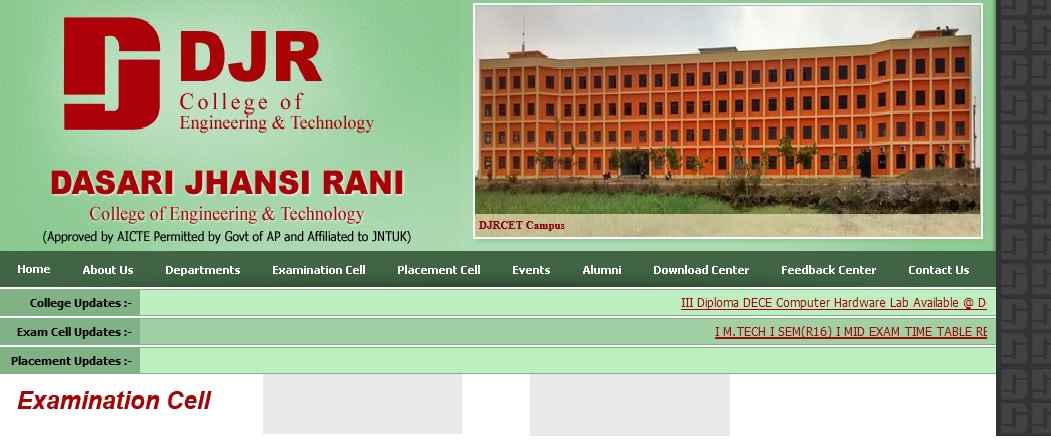R05320501 Computer Graphics B.Tech Question Paper : djriet.edu.in
Name of the College : Dasari Jhansi Rani Institute Of Engineering And Technology
University : JNTUK
Department : Computer Science And Engineering
Subject Code/Name : R05320501 – Computer Graphics
Year : 2008
Degree : B.Tech
Year/Sem : III/II
Website : djriet.edu.in
Document Type : Model Question Paper
Computer Graphics Regular : https://www.pdfquestion.in/uploads/djriet.edu.in/2939-R05320501-COMPUTER-GRAPHICS.pdf
Computer Graphics Supple : https://www.pdfquestion.in/uploads/djriet.edu.in/2939_R05320501-COMPUTER-GRAPHICS.pdf
Computer Graphics Supple Aug/Sep 2008 : https://www.pdfquestion.in/uploads/djriet.edu.in/2939–RR320502-COMPUTER-GRAPHICS.pdf
DJRIET Computer Graphics Question Paper
Set No. 1
(Computer Science & Engineering)
Time: 3 hours
Max Marks: 80
Answer any FIVE Questions :
Related : Dasari Jhansi Rani Institute Of Engineering Technology Advanced Unix Programming B.Tech Question Paper : www.pdfquestion.in/2938.html
All Questions carry equal marks :
1. (a) Consider the raster system with resolution of 1280 by 1024. What size frame buffer (in bytes) is needed for the systems to store if 24 bits pixel are to be stored.
(b) How long would it take to load a 640 × 480 frame buffer with 12 bits per pixel, if 105 bits can be transferred per second. [8+8]
2. (a) Devise a parallel method for implementing line-width function.
(b) Show why the point-to-line error is always 1 2 for the mid-point line scan conversion algorithm. [10+6]

3. Show that the transformation matrix for a reflection about the line y = -x is equivalent to a reflection relative to the y-axis followed by a counter clockwise rotation of 900. [16]
4. (a) What are the basic transformation techniques used in Window-to-Viewport transformation? Derive the viewing transformation matrix.
(b) What is the significance of 4-bit region code is Cohen-Sutherland algorithm? [8+8]
5. List and describe the algorithm steps of any two shading models for polygons. Compare them. [16]
6. Let an axis of rotation L be specified by a direction vector V and a location point P. Find the transformation for a rotation of ?0 about L. [16]
7. (a) Explain the possible relationships between polygon surfaces while implementing area-subdivision method. How to handle these cases.
(b) Illustrate with an example a scence consisting of three or more planes and explain how the BSP tree is constructed to represent the scene. [8+8]
8. What are the steps in design of animation sequence? Describe about each step briefly. [16]
Set No. 2
1. (a) Assuming that a certain full-color (24-bit per pixel) RGB raster system has a 512 by 512 frame buffer, how many distinct color choices (intensity levels) would be available.
(b) Explain how virtual reality systems can be used in design applications. [10+6]
2. (a) Explain how the pixel screen positions are stored and retrieved from frame buffer.
(b) What are the steps involved in mid point circle algorithm? [8+8]
3. Prove that the multiplication matrices for each of the following sequence of operations is commutative [16]
(a) Two successive rotations
(b) Two successive translations
(c) Two successive scalings.
4. (a) How the clipping-candidate (partially visible) case is handled in Cohen-Sutherland algorithm.
(b) Derive the Window-to-View port transformation. [8+8]
5. (a) Distinguish between boundary representation and space-partitioning representation of solid object representation schemes.
(b) List and describe the polygon tables representation for polygon surfaces of a 3-D object. Give an example. [8+8]
6. Explain how the shearing of an object with respect to the three coordinate axes are implemented. What are the corresponding input values for the shearing parameters. [16]
7. (a) Explain the depth-sorting algorithm for visible surface detection.
(b) What are the special cases in determining the depth-order of surfaces? Explain the procedure to resolve them with suitable examples. [8+8]
8. What are the steps in design of animation sequence? Describe about each step briefly. [16]
Set No. 3
Answer any FIVE Questions :
All Questions carry equal marks
1. List the operating characterstics of
(a) Raster refresh systems
(b) Vector refresh systems
(c) Plasma panel
(d) LCDs. [4×4=16]
2. (a) Use the mid-point method to derive a decision parameter for generating points along a straight line path with slope in the range 0 (b) Use the mid-point method and symmetry considerations propose a solution to scan convert the parabola. x=y2 for the interval – 10 y 10. [8+8]
3. (a) Describe the transformation which reflects an object about an arbitrary line L.
(b) What is the relationship among rotation (R) , inverse rotation (R-) and coordinate rotation (R1 [8+8]
4. (a) Give a brief note about two dimensional viewing functions. Give an example which uses two dimensional viewing functions.
(b) Explain the Cohen-Sutherland line clipping algorithm. [8+8]
5. (a) Classify the reflections. What are the characteristics of each? Illustrate with suitable figures.
(b) Describe the Phong illumination model. Explain the parameters used in phong’s model.